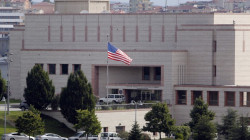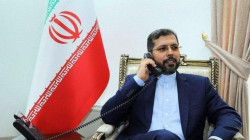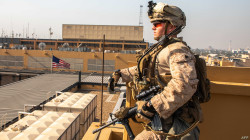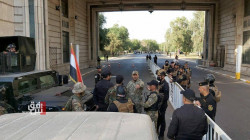The Inside Story of the U.S. Embassy Attack in Baghdad
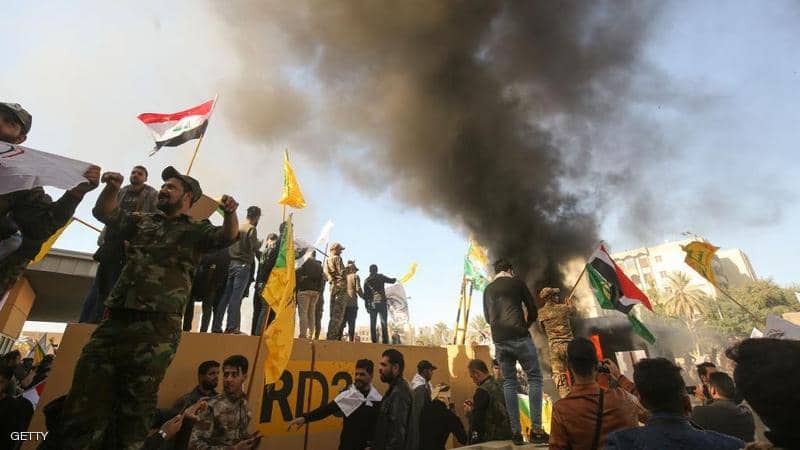
Shafaq news/ The US time magazine revealed, on Thursday, new details about the storming of the Washington embassy in Baghdad at the end of December 2019, citing US officers.
The magazine said, “It was a balmy, overcast New Year’s Eve in Baghdad in 2019, and six Diplomatic Security agents were fending off enraged Iraqi protestors trying to surge into their compound. The Iraqis had started by throwing Molotov cocktails over the perimeter wall, in an apparent attempt to set fire to the embassy’s fuel depot. Now they were trying to force open two doors on either side of the compound’s northeastern gate.”
“The Time” continued “Special agent Michael Yohey, a 43-year-old Army veteran from Fredericksburg, Va., could hear a lot of chaotic chatter over his radio about protestors trying to get in. He rushed toward the northernmost embassy gate to join a handful of security contractors who were already there, trying to beat back dozens of Iraqi protestors who had forced open doors on either side of the gate. But the worst had already happened: the embassy compound had been breached.”
“The six agents, who led the embassy’s emergency response team of roughly two dozen security contractors that day, have now been nominated for federal law enforcement awards for their bravery. For roughly ten hours, they staved off thousands of protestors that came at them in waves, lobbing flaming fuel bombs and chunks of broken concrete. No one died.
“They were trying to get us to kill one of them,” says one of two senior security officials that took part that day, who spoke anonymously to describe the riots that threatened in the first hour to overwhelm the compound’s defenses. This account of the fraught hours at the U.S. embassy is based interviews with the six agents who were at the front lines of the protests, their award citation, and interviews with other senior U.S. officials who were part of the response.” It continued.
“They’re over the bridge”
The magazine stated the beginning of the incident, “It was a Tuesday morning, and the Diplomatic Security agents knew that Iraqi militiamen had started their funeral march near the center of the capital, on a road on the other side of the wide, muddy Dijlah River, across from the international zone that housed the embassy and key Iraqi government offices and residences.
They were on alert, but they weren’t especially worried; they thought Iraqi security forces would keep the angry marchers from coming over the heavily guarded bridge that marks the entrance from the city center to the government area. The international zone, once called the “Green Zone,” is no longer filled with canyon-like high blast walls as it was when U.S. forces occupied the country.”
“ Most of the international zone’s walls were dismantled by 2019, but there were still a few key security chokepoints where Iraqi security forces could control the public’s entry.
A bit before 10:30 that morning, Special Agent John Huey, 41, got a call from an Iraqi security official he’d befriended. They’re coming over the bridge, the Iraqi said, and there’s nothing we can do. Somewhere in the senior ranks of Iraqi government, officials had decided to allow the marchers through.” It added
The agents, most of whom were in their command center inside the compound, watched incredulously through the security cameras that studded the exterior of the embassy compound. Hundreds, then thousands, of Iraqi protestors filled Al Kindi Street, a wide and normally empty avenue outside the embassy. “It happened very quickly from this group marching on their funeral procession parallel to the embassy. The next thing I heard is, ‘Oh, they’re on the bridge…They’re over the bridge,” recalls Huey, an Atlanta native and the incident commander for what was to unfold that day. “They were just simply allowed to drive in.”
“At first, the protestors looked like they were planning a peaceful demonstration, putting up tents and political banners. They hung a massive militia flag on an apartment building across Al Kindi Street, one of several tower blocks in the government area that housed Iraqis important enough to merit a home within the semi-protected international zone.” It added.
The apartment building complex, which faced the embassy, quickly became a de facto base of operations for the mix of Shia militia groups that had gathered in front of the embassy to vent their rage.” It cited
It continued, “It seemed obvious to the Diplomatic Security agents that the militia members had carefully plotted out the attack. Not long after setting up their tents, they began systematically taking out the embassy’s exterior security cameras, says special agent Ian Mackenzie, 35, a former Missouri police officer. “They were going around with large poles and knocking down the cameras to limit our views on the outside of what was going on.”
“The Americans inside the embassy were now on high alert, and following a set of emergency protocols they’d rehearsed multiple times.
“Diplomatic Security special agent Evan Tsurumi, 41, who led the embassy’s quick reaction force that day, joined an embassy marksman on a rooftop to get an aerial view of the crowd. At that point, the crowd hadn’t yet turned violent. Tsurumi, a former New York city paramedic and Navy corpsman, saw thousands gathered outside, some carrying flags and a few carrying weapons. They were mostly young men in their early 20s, some of them wearing their forces’ uniforms. “They were much disciplined and they had an agenda,” he says, on a recent video call with TIME, together with other agents.
“The crowd’s mood changed fast. A little more than an hour after they arrived, the protestors, shouting “Death to America,” gathered at the northeast end of the U.S. Embassy compound, and started lobbing Molotov cocktails – flaming bottles filled with fuel – at the embassy’s fuel depot just inside the wall. It was a strategic target that U.S. special agents say the protestors must have chosen well in advance, hoping to start a fire that would lead to a massive explosion.”
Huey and special agent Mike Ross, a 37-year-old Marine reservist, ran towards the fuel farm, where the embassy’s firemen — a mixture of American and foreign contractors — were already trying to put out the blaze around the tanks before it ignited the fuel within.
“We were dodging rocks,” Huey says, “a surprisingly massive volume of rocks and Molotov cocktails.” At least they were trying to dodge them. Every agent and security force member defending the main gates that day got hit by some sort of flying projectile—chunks of brick or pavement the protestors dug out of the road outside the embassy, or baseball-sized rocks the rioters apparently brought with them from outside the international zone. The rocks mostly bounced off the American team’s military-style helmets and bulletproof vests, but were still large enough to rattle the brain, and cut and bruise arms and legs in what was to become an hours-long fight.
The first wave is repelled
The magazine continued, “The handful of agents and their embassy security force — roughly a dozen in all — formed a half-moon around the protestors who’d made it inside, and tried to push them out. They opened fire with a range of “non-lethal” weapons: tear gas; “flash-bang” percussive grenades; and “stinger balls,” dense rubber balls fired from grenade launchers, usually aimed at the ground to bounce up and smack the protestors in the knees or gut.
They managed to force the first wave back out into the street, but a second surge of about 50 protestors soon forced their way in. Huey was concerned his team was about to be overrun — and if that happened, he worried that the security team on the embassy buildings above would make the call to use lethal force, which he feared would draw fire from armed militiamen he had spotted in the street, who had been careful not to approach the embassy compound. “We unleashed a really robust volley of less-than-lethal munitions on the crowd,” Huey says, but the rioters just kept coming.
That’s also when Huey spotted Iraqi counterterrorism troops making their way from the street through the surging protestors. They were trying to get the militia members out of the compound. “And at that point, it became very apparent to me that we needed to regain control” while also giving the Iraqi counterterrorism forces some space to work their way through the crowd and convince them to exit the compound.
Huey jumped between his line of agents and guards, and the Iraqi protestors, and in a hoarse voice, shouted to all of them, “Everyone calms” And everyone, including the Iraqis, took a step back. It worked “surprisingly well,” he recalls with a grin. “And we all were able to kind of stop the aggressive onslaught that we had unleashed on these folks,” and the Iraqi counterterrorism troops were able to shepherd the militiamen out.”
That was in the first hour of what was to become a day-long melee, with the protestors besieging the embassy gates in coordinated waves. Fifty or so protesters would surge at the gate and then fall back, replaced by 50 more, according to a senior security official who was monitoring the protest from the base across the street, speaking on condition of anonymity. The Diplomatic Security agents were eventually able to force the gates shut.
More attacks
“DSS Special Agent Evan Tsurumi, front-center, helps to remove a burning obstacle during an attack on the U.S. embassy in Baghdad. In the background, DSS Special Agent Mike Yohey and others examine ways to barricade an entrance at the embassy.
DSS Special Agent Evan Tsurumi, front-center helps to remove a burning obstacle during an attack on the U.S. embassy in Baghdad.
In the background, DSS Special Agent Mike Yohey and others examine ways to barricade an entrance at the embassy. Mike Ross—Courtesy U.S. State Department” it added.
“The rest of the day was kind of a standoff with various breaks where they would probe different defenses, throw more gas bombs” and thousands of baseball-sized rocks, Tsurumi says, describing the defensive mission as a marathon. “We were alone there without any assistance for approximately 10 hours, you know, just working creatively.”
The agents were now also serving as firefighters, as their contractors weren’t paid to fight fire while under attack. The rioters kept throwing Molotov cocktails over the wall where a number of embassy vehicles were parked, so Mackenzie, who had joined the fight at the Red gate, scrambled to find keys to the flaming vehicles, jump into them, and drive them away from the walls in order to put the fires out.
What the agents couldn’t know from their vantage point in the middle of the fight on ground is that the U.S. military had teams on standby in Iraq, the Gulf, Europe and even back in the U.S. to flood the embassy, guard the interior and evacuate the diplomats if need be, say both senior security officials, speaking on condition of anonymity to describe the response.
In Washington, Senior State Department officials, including Secretary of State Mike Pompeo and Iran envoy Brian Hook, were watching the siege from multiple cameras that remained inside the embassy, as well as the military’s cameras trained on the street from the joint U.S.-Iraqi military base, Union III, catty corner from the diplomatic compound on the opposite side of Al Kindi Street.
Waiting it out
By nightfall of the first day, the agents had secured the gates, and multiple Iraqi officials including the Minister of Interior and Iraqi militia commander General al-Muhandis had visited the protestors to calm them down. Iraqi officials tell TIME they worked as fast as they could to de-escalate the situation, which they insist was more symbolic than an actual danger to those inside. An aide to then-Prime Minister Abdul Mahdi said the U.S. airstrikes against militia members, carried out without alerting the prime minister, had created a level of anger within government ranks that had to be handled carefully.
“Around midnight, the protestors stepped up their harassment again, shouting “Happy New Year” to the agents inside, before firing commercial-grade fireworks first into the air, and then directly at the Americans. “But it wasn’t a mortar or an RPG,” a rocket-propelled grenade, one of the security officials says, and launching fireworks to harass those inside the U.S. embassy and military compounds was also a regular weekend occurrence, the second security official says. So, the agents just hunkered down, and prepared to put out any fires the incendiary volleys might start.
Day two of the protests felt more like a PR exercise on the militia’s part, Huey says. Protestors milled about, listening to loud sound systems blaring patriotic militia music, while the Americans, including more than 100 extra Marines sent by the Pentagon, mostly waited it out. At one point, the Americans fired tear gas at an energetic group of protesters that had climbed atop one of the burned reception buildings, but for the most part, the battle was over. At the end of the day, the protestors, heeding demands from their own militia leaders to stop, packed up their tents and departed.
That’s when the U.S. military flooded the embassy with more defenses, under cover of darkness, in anticipation of the next round of payback, one of the senior security officials says.
“But this time, protestors weren’t allowed to reach the street outside the U.S. embassy. The Iraqi prime minister’s forces kept them out. Pompeo had warned him after the embassy breach on New Year’s Eve that the U.S. would “protect and defend its people” if the embassy was attacked again.
Throughout those two tense days, the agents were all getting frantic messages from loved ones back home, watching the violence unfold as it was filmed by local and international media, and the protestors themselves, in what was all about the ritual humiliation of the Americans inside. “My wife was just beside herself. It was absolutely terrifying for her,” Mackenzie says. When he returned to the U.S. weeks later, “she essentially told me, you’re not going back.” He hasn’t returned since, though Huey and some of the other agents’ have.” it said
The six men were just named recipients of this year’s Federal Law Enforcement Officers Association National Award for Uncommon Valor, and the entire Baghdad security team has been nominated for the State Department’s heroism award for keeping their cool in the face of an opponent who was trying to goad them into violence.
Huey says they knew that if things went wrong that night, the war might start.”
